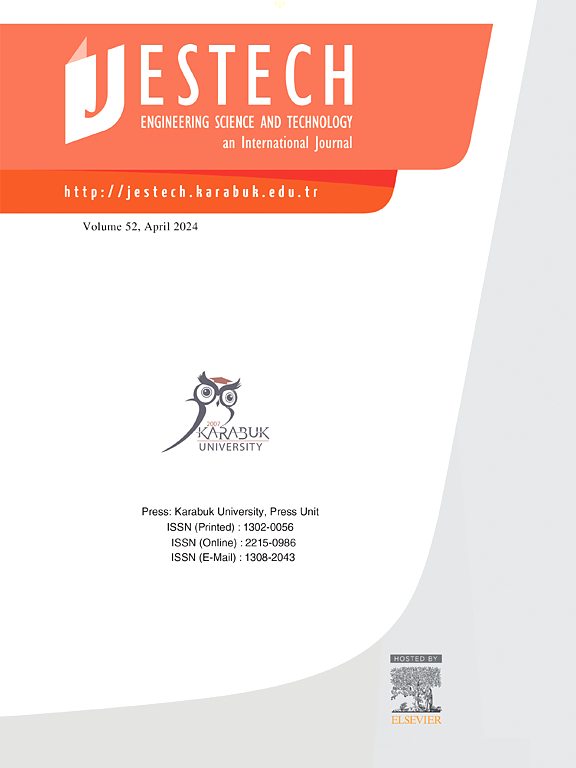A novel pixel antenna by using a genetic algorithm for Wi-Fi 6E applications
IF 5.4
2区 工程技术
Q1 ENGINEERING, MULTIDISCIPLINARY
Engineering Science and Technology-An International Journal-Jestech
Pub Date : 2025-04-30
DOI:10.1016/j.jestch.2025.102072
引用次数: 0
Abstract
The number of wireless devices is increasing daily, and these gadgets have become indispensable in people’s daily lives, requiring speedy and unlimited internet access. This may cause the currently used frequency bands to be insufficient or overcrowded. Adding the 6 GHz spectrum as a Wi-Fi 6E may assist in reducing traffic on other bands. However, the large bandwidth raises antenna design difficulties, and this article brings a new antenna proposal to this issue. It is a novel pixel patch antenna optimized by a metaheuristic optimization algorithm for Wi-Fi 6E applications. The shape of the radiating patch is determined using genetics, which is a basic algorithm based on population to achieve wideband operation. The antenna radiating element is divided into small pixel-shaped squares, then, some of them are removed for broadband operation. The antenna is constructed with the FR4 dielectric material, and it has a compact volume of 25 x 25 x 1.6 mm3. The measured impedance bandwidth of the antenna varies between 5.75 GHz and 8.46 GHz, with the maximum radiation efficiency and a gain of values of 67 % and 4.5 dBi. As a result, the suggested antenna may be employed for Wi-Fi 6E applications.
采用遗传算法的新型像素天线,用于Wi-Fi 6E应用
无线设备的数量每天都在增加,这些小工具已经成为人们日常生活中不可或缺的一部分,需要快速和无限制的互联网接入。这可能导致当前使用的频带不足或过度拥挤。增加6ghz频谱作为Wi-Fi 6E可能有助于减少其他频段的流量。然而,大带宽给天线设计带来了困难,本文针对这一问题提出了一种新的天线方案。它是一种采用元启发式优化算法优化的新型像素贴片天线,适用于Wi-Fi 6E应用。利用遗传算法确定辐射斑的形状,遗传算法是实现宽带操作的一种基于种群的基本算法。天线辐射单元被分割成小的像素形状的正方形,然后,其中一些被移除用于宽带操作。该天线由FR4介电材料构成,体积紧凑,为25 x 25 x 1.6 mm3。该天线的测量阻抗带宽在5.75 GHz ~ 8.46 GHz之间,最大辐射效率为67%,增益为4.5 dBi。因此,建议的天线可用于Wi-Fi 6E应用。
本文章由计算机程序翻译,如有差异,请以英文原文为准。
求助全文
约1分钟内获得全文
求助全文
来源期刊

Engineering Science and Technology-An International Journal-Jestech
Materials Science-Electronic, Optical and Magnetic Materials
CiteScore
11.20
自引率
3.50%
发文量
153
审稿时长
22 days
期刊介绍:
Engineering Science and Technology, an International Journal (JESTECH) (formerly Technology), a peer-reviewed quarterly engineering journal, publishes both theoretical and experimental high quality papers of permanent interest, not previously published in journals, in the field of engineering and applied science which aims to promote the theory and practice of technology and engineering. In addition to peer-reviewed original research papers, the Editorial Board welcomes original research reports, state-of-the-art reviews and communications in the broadly defined field of engineering science and technology.
The scope of JESTECH includes a wide spectrum of subjects including:
-Electrical/Electronics and Computer Engineering (Biomedical Engineering and Instrumentation; Coding, Cryptography, and Information Protection; Communications, Networks, Mobile Computing and Distributed Systems; Compilers and Operating Systems; Computer Architecture, Parallel Processing, and Dependability; Computer Vision and Robotics; Control Theory; Electromagnetic Waves, Microwave Techniques and Antennas; Embedded Systems; Integrated Circuits, VLSI Design, Testing, and CAD; Microelectromechanical Systems; Microelectronics, and Electronic Devices and Circuits; Power, Energy and Energy Conversion Systems; Signal, Image, and Speech Processing)
-Mechanical and Civil Engineering (Automotive Technologies; Biomechanics; Construction Materials; Design and Manufacturing; Dynamics and Control; Energy Generation, Utilization, Conversion, and Storage; Fluid Mechanics and Hydraulics; Heat and Mass Transfer; Micro-Nano Sciences; Renewable and Sustainable Energy Technologies; Robotics and Mechatronics; Solid Mechanics and Structure; Thermal Sciences)
-Metallurgical and Materials Engineering (Advanced Materials Science; Biomaterials; Ceramic and Inorgnanic Materials; Electronic-Magnetic Materials; Energy and Environment; Materials Characterizastion; Metallurgy; Polymers and Nanocomposites)
 求助内容:
求助内容: 应助结果提醒方式:
应助结果提醒方式:


